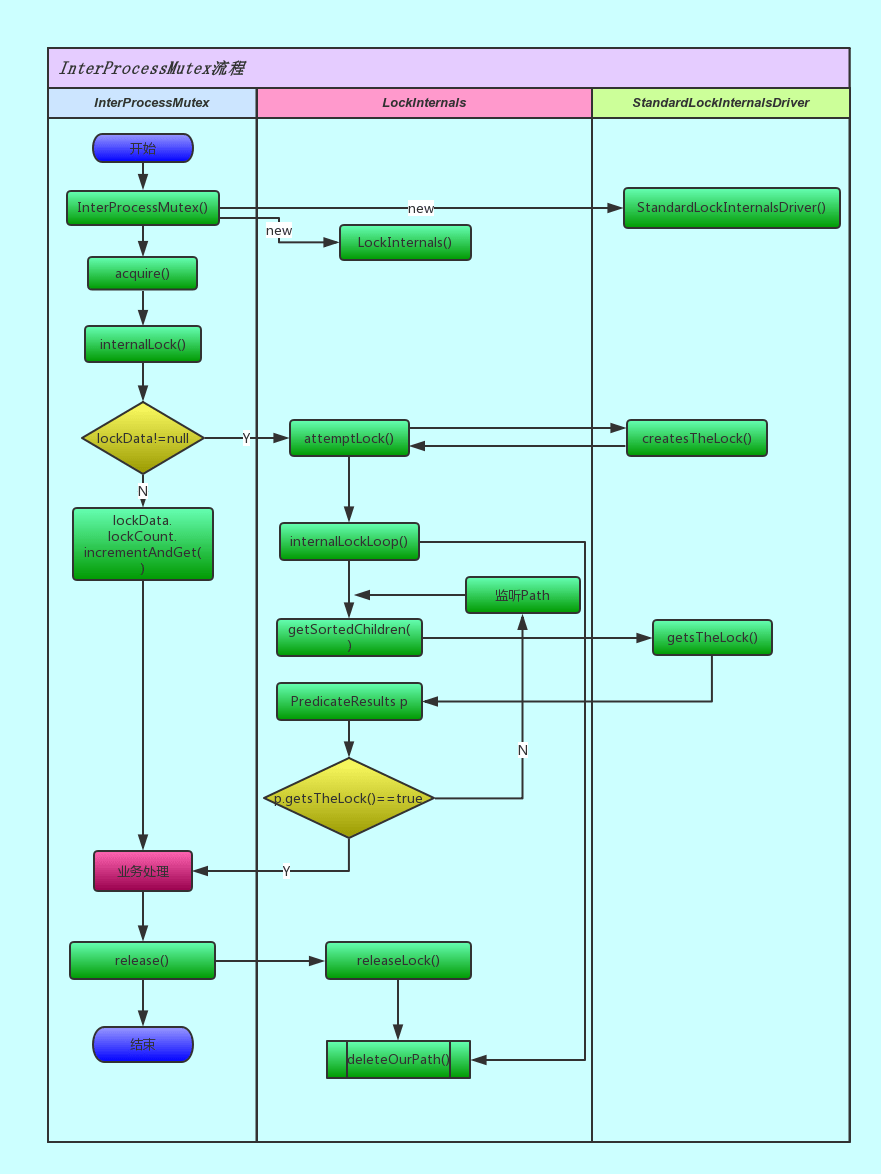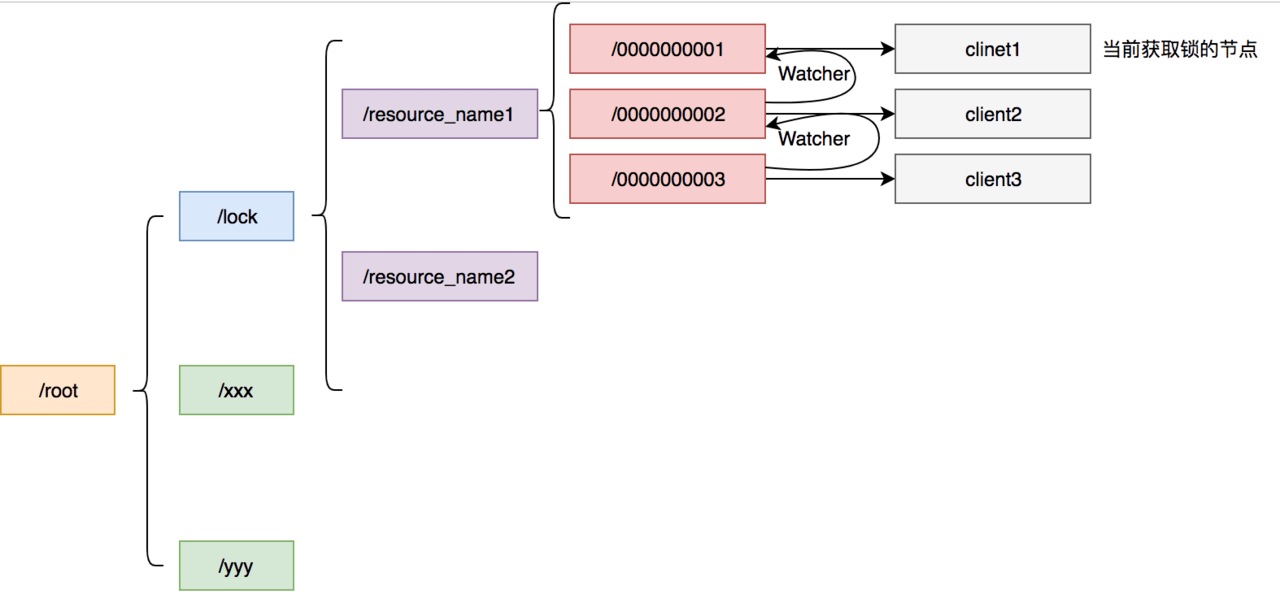分布式锁之 Apache Curator InterProcessMutex

对分布式锁耳熟能详。不过,一直关注的是基于 Redis 实现的分布式锁。知道 ZooKeeper 也可以实现分布式锁。但是,原来的想法是把 Redis 那个思路切换到 ZooKeeper 上来实现就好。今天了解到 Apache Curator 内置了分布式锁的实现: InterProcessMutex。查看了一下源码实现,发现跟基于 Redis 实现的源码相比,在思路上还是有很大不同的。所以,特别作文记录一下。
先来看一下,整体流程:

结合流程图和源码,加锁的过程是这样的:
先判断本地是否有锁数据,如果有则对锁定次数自增一下,然后返回
true;如果没有锁数据,则尝试获取锁:
在指定路径下创建临时顺序节点
获取指定路径下,所有节点,检查自身是否是序号最小的节点:
如果自身序号最小,则获得锁;否则
如果自身不是序号最小的节点,则通过
while自旋 +wait(times)不断尝试获取锁,直到成功。
获得锁后,把锁信息缓存在本地
ConcurrentMap<Thread, LockData> threadData变量中,方便计算重入。
在 ZooKeeper 中的结构大致如下:

下面我们逐个方法进行分析说明。先来看一下 InterProcessMutex 的注释:
/**
* A re-entrant mutex that works across JVMs. Uses Zookeeper to hold the lock. All processes in all JVMs that
* use the same lock path will achieve an inter-process critical section. Further, this mutex is
* "fair" - each user will get the mutex in the order requested (from ZK's point of view)
*/
public class InterProcessMutex implements InterProcessLock, Revocable<InterProcessMutex>从注释中,我们可以得出这么几点信息:
这是一个可以跨越 JVM 的可重入互斥锁。
使用 ZooKeeper 来保存锁信息。
所有线程都使用相同的锁路径来锁定跨线程的关键部分。
这是一个公平锁。
构造函数
private final LockInternals internals;
private final String basePath;
private final ConcurrentMap<Thread, LockData> threadData = Maps.newConcurrentMap();
private static class LockData
{
final Thread owningThread;
final String lockPath;
final AtomicInteger lockCount = new AtomicInteger(1);
private LockData(Thread owningThread, String lockPath)
{
this.owningThread = owningThread;
this.lockPath = lockPath;
}
}
private static final String LOCK_NAME = "lock-";
/**
* @param client client
* @param path the path to lock
*/
public InterProcessMutex(CuratorFramework client, String path)
{
this(client, path, new StandardLockInternalsDriver());
}
/**
* @param client client
* @param path the path to lock
* @param driver lock driver
*/
public InterProcessMutex(CuratorFramework client, String path, LockInternalsDriver driver)
{
this(client, path, LOCK_NAME, 1, driver);
}
InterProcessMutex(CuratorFramework client, String path, String lockName, int maxLeases, LockInternalsDriver driver) (1)
{
basePath = PathUtils.validatePath(path);
internals = new LockInternals(client, driver, path, lockName, maxLeases);
}| 1 | 注意这个构造函数没有 public 修饰符。 |
从这段代码我们可以看出:
可以利用
CuratorFramework实例和path就可以创建一个锁对象;锁数据包含持有线程(
owningThread),锁路径(lockPath)和锁定次数(lockCount);使用
ConcurrentMap建立起线程和锁数据的关联。
来看一下获取锁的流程:
获得锁
acquire 方法
/**
* Acquire the mutex - blocking until it's available. Note: the same thread
* can call acquire re-entrantly. Each call to acquire must be balanced by a call
* to {@link #release()}
*
* @throws Exception ZK errors, connection interruptions
*/
@Override
public void acquire() throws Exception
{
if ( !internalLock(-1, null) )
{
throw new IOException("Lost connection while trying to acquire lock: " + basePath);
}
}
/**
* Acquire the mutex - blocks until it's available or the given time expires. Note: the same thread
* can call acquire re-entrantly. Each call to acquire that returns true must be balanced by a call
* to {@link #release()}
*
* @param time time to wait
* @param unit time unit
* @return true if the mutex was acquired, false if not
* @throws Exception ZK errors, connection interruptions
*/
@Override
public boolean acquire(long time, TimeUnit unit) throws Exception
{
return internalLock(time, unit);
}这里面有一点需要注意:the same thread can call acquire re-entrantly. Each call to acquire must be balanced by a call to {@link #release()}.(相同线程可以重复调用 acquire,但是每次调用 acquire,也必须有对应的 release 方法。)这点跟 Java 的 ReentrantLock 语义是相同的。
由于两个 acquire 方法都调用了 internalLock 方法,我们来看一下这个方法:
internalLock 方法
private boolean internalLock(long time, TimeUnit unit) throws Exception
{
/*
Note on concurrency: a given lockData instance
can be only acted on by a single thread so locking isn't necessary
*/
Thread currentThread = Thread.currentThread();
LockData lockData = threadData.get(currentThread);
if ( lockData != null )
{
// re-entering
lockData.lockCount.incrementAndGet();
return true;
}
String lockPath = internals.attemptLock(time, unit, getLockNodeBytes());
if ( lockPath != null )
{
LockData newLockData = new LockData(currentThread, lockPath);
threadData.put(currentThread, newLockData);
return true;
}
return false;
}这段代码,就可以看出 InterProcessMutex 对重入的处理:针对对应的锁数据自增调用次数,然后直接返回 true。
如果没有则尝试去获取锁,成功后将锁数据放入到上面提到的 threadData 变量中。
在上面介绍构造函数时,在构造函数创建了 internals 对象,接下来看一下 attemptLock 方法。
attemptLock 方法
org.apache.curator.framework.recipes.locks.LockInternals#attemptLockString attemptLock(long time, TimeUnit unit, byte[] lockNodeBytes) throws Exception
{
final long startMillis = System.currentTimeMillis();
final Long millisToWait = (unit != null) ? unit.toMillis(time) : null;
final byte[] localLockNodeBytes = (revocable.get() != null) ? new byte[0] : lockNodeBytes;
int retryCount = 0;
String ourPath = null;
boolean hasTheLock = false;
boolean isDone = false;
while ( !isDone )
{
isDone = true;
try
{
ourPath = driver.createsTheLock(client, path, localLockNodeBytes);
hasTheLock = internalLockLoop(startMillis, millisToWait, ourPath);
}
catch ( KeeperException.NoNodeException e )
{
// gets thrown by StandardLockInternalsDriver when it can't find the lock node
// this can happen when the session expires, etc. So, if the retry allows, just try it all again
if ( client.getZookeeperClient().getRetryPolicy().allowRetry(retryCount++, System.currentTimeMillis() - startMillis, RetryLoop.getDefaultRetrySleeper()) )
{
isDone = false;
}
else
{
throw e;
}
}
}
if ( hasTheLock )
{
return ourPath;
}
return null;
}这个方法中,可以看出获取锁要进行:
创建锁节点
调用
internalLockLoop获取锁
这里还通过 while 循环来达到重试效果。
先来看一下是如何创建锁节点的:
createsTheLock 方法
org.apache.curator.framework.recipes.locks.StandardLockInternalsDriver#createsTheLock@Override
public String createsTheLock(CuratorFramework client, String path, byte[] lockNodeBytes) throws Exception
{
String ourPath;
if ( lockNodeBytes != null )
{
ourPath = client.create().creatingParentContainersIfNeeded().withProtection().withMode(CreateMode.EPHEMERAL_SEQUENTIAL).forPath(path, lockNodeBytes);
}
else
{
ourPath = client.create().creatingParentContainersIfNeeded().withProtection().withMode(CreateMode.EPHEMERAL_SEQUENTIAL).forPath(path);
}
return ourPath;
}这里就是通过 CuratorFramework 实例来创建 CreateMode.EPHEMERAL_SEQUENTIAL 类型的节点。
再来看一下 internalLockLoop 方法
internalLockLoop 方法
org.apache.curator.framework.recipes.locks.LockInternals#internalLockLoopprivate boolean internalLockLoop(long startMillis, Long millisToWait, String ourPath) throws Exception
{
boolean haveTheLock = false;
boolean doDelete = false;
try
{
if ( revocable.get() != null )
{
client.getData().usingWatcher(revocableWatcher).forPath(ourPath);
}
while ( (client.getState() === CuratorFrameworkState.STARTED) && !haveTheLock )
{
List<String> children = getSortedChildren();
String sequenceNodeName = ourPath.substring(basePath.length() + 1); // +1 to include the slash
PredicateResults predicateResults = driver.getsTheLock(client, children, sequenceNodeName, maxLeases);
if ( predicateResults.getsTheLock() )
{
haveTheLock = true;
}
else
{
String previousSequencePath = basePath + "/" + predicateResults.getPathToWatch();
synchronized(this)
{
try
{
// use getData() instead of exists() to avoid leaving unneeded watchers which is a type of resource leak
client.getData().usingWatcher(watcher).forPath(previousSequencePath);
if ( millisToWait != null )
{
millisToWait -= (System.currentTimeMillis() - startMillis);
startMillis = System.currentTimeMillis();
if ( millisToWait <= 0 )
{
doDelete = true; // timed out - delete our node
break;
}
wait(millisToWait);
}
else
{
wait();
}
}
catch ( KeeperException.NoNodeException e )
{
// it has been deleted (i.e. lock released). Try to acquire again
}
}
}
}
}
catch ( Exception e )
{
ThreadUtils.checkInterrupted(e);
doDelete = true;
throw e;
}
finally
{
if ( doDelete )
{
deleteOurPath(ourPath);
}
}
return haveTheLock;
}这个方法是 InterProcessMutex 锁最关键的一个方法:
它使用
while自旋实现了不断尝试获得锁;为了避免不必要的自旋浪费资源,使用
wait(time)来“限时”等待;如果超时,则结束循环,删除节点信息。
这个方法中,有一行代码要特别注意,D瓜哥把上下文相关的代码都整理出来:
org.apache.curator.framework.recipes.locks.LockInternals#internalLockLoopString previousSequencePath = basePath + "/" + predicateResults.getPathToWatch();
// 注意下面这行代码
client.getData().usingWatcher(watcher).forPath(previousSequencePath);
// watcher 变量对应的
private final Watcher watcher = new Watcher()
{
@Override
public void process(WatchedEvent event)
{
client.postSafeNotify(LockInternals.this);
}
};
// org.apache.curator.framework.CuratorFramework#postSafeNotify 的代码
default CompletableFuture<Void> postSafeNotify(Object monitorHolder)
{
return runSafe(() -> {
synchronized(monitorHolder) {
monitorHolder.notifyAll();
}
});
}这行关键的代码的意思是:监听上一个节点(排序后前一个节点)的变化。因为在 internalLockLoop 方法中调用了 wait(time) 方法,将运行线程等待;所以,需要一个唤醒操作。而这个监听事件就实现了唤醒操作。
监听上一个节点变化是为了防止羊群效应的出现。因为只有一个线程获得锁,过多线程唤醒只会造成无用的操作,浪费资源。
这里有一个需要深入思考的点:如果前一个节点删除,这个线程还会被唤醒吗?答案是可以的。逻辑这样的:前一个节点删除,必然触发一个事件,这个事件就可以唤醒已经等待的线程;线程就会做一个循环,检查是否能获得锁,如果可以就结束循环;如果不可以,则会再次选择前一个节点注册监听器,然后进入等待状态。
来看一下它如何获取孩子节点的:
getSortedChildren 方法
org.apache.curator.framework.recipes.locks.LockInternals#getSortedChildrenpublic static List<String> getSortedChildren(CuratorFramework client, String basePath, final String lockName, final LockInternalsSorter sorter) throws Exception
{
try
{
List<String> children = client.getChildren().forPath(basePath);
List<String> sortedList = Lists.newArrayList(children);
Collections.sort
(
sortedList,
new Comparator<String>()
{
@Override
public int compare(String lhs, String rhs)
{
return sorter.fixForSorting(lhs, lockName).compareTo(sorter.fixForSorting(rhs, lockName));
}
}
);
return sortedList;
}
catch ( KeeperException.NoNodeException ignore )
{
return Collections.emptyList();
}
}
List<String> getSortedChildren() throws Exception
{
return getSortedChildren(client, basePath, lockName, driver);
}这个方法也比较简单,获取所有孩子节点,然后对其进行排序,返回排序后的结果。
再来看看 getsTheLock 方法:
getsTheLock 方法
org.apache.curator.framework.recipes.locks.StandardLockInternalsDriver#getsTheLock@Override
public PredicateResults getsTheLock(CuratorFramework client, List<String> children, String sequenceNodeName, int maxLeases) throws Exception
{
int ourIndex = children.indexOf(sequenceNodeName);
validateOurIndex(sequenceNodeName, ourIndex);
boolean getsTheLock = ourIndex < maxLeases;
String pathToWatch = getsTheLock ? null : children.get(ourIndex - maxLeases);
return new PredicateResults(pathToWatch, getsTheLock);
}初次看这个方法,还有些懵逼。从上往下捋下来,现在看其实很简单,对一个排过序的数组,检查自己是否是第一个节点,如果是就表示自身是最小节点,获得锁。
上面还有超时后删除节点的操作,也顺道看一下:
deleteOurPath 方法
private void deleteOurPath(String ourPath) throws Exception
{
try
{
client.delete().guaranteed().forPath(ourPath);
}
catch ( KeeperException.NoNodeException e )
{
// ignore - already deleted (possibly expired session, etc.)
}
}这个方法很简单,就是直接删除自身节点信息。
释放锁
release 方法
org.apache.curator.framework.recipes.locks.InterProcessMutex#release/**
* Perform one release of the mutex if the calling thread is the same thread that acquired it. If the
* thread had made multiple calls to acquire, the mutex will still be held when this method returns.
*
* @throws Exception ZK errors, interruptions, current thread does not own the lock
*/
@Override
public void release() throws Exception
{
/*
Note on concurrency: a given lockData instance
can be only acted on by a single thread so locking isn't necessary
*/
Thread currentThread = Thread.currentThread();
LockData lockData = threadData.get(currentThread);
if ( lockData === null )
{
throw new IllegalMonitorStateException("You do not own the lock: " + basePath);
}
int newLockCount = lockData.lockCount.decrementAndGet();
if ( newLockCount > 0 )
{
return;
}
if ( newLockCount < 0 )
{
throw new IllegalMonitorStateException("Lock count has gone negative for lock: " + basePath);
}
try
{
internals.releaseLock(lockData.lockPath);
}
finally
{
threadData.remove(currentThread);
}
}因为是重入锁,所以需要将锁定次数减少到零才能彻底释放锁。
releaseLock 方法
org.apache.curator.framework.recipes.locks.LockInternals#releaseLockfinal void releaseLock(String lockPath) throws Exception
{
client.removeWatchers();
revocable.set(null);
deleteOurPath(lockPath);
}释放锁也很简单,删除节点上的监听器,删除节点即可。
总结
由于 ZooKeeper 本身支持创建顺序节点,所以可以监听前一个节点,这样就可以打打减少事件传播的广度,减少无用的唤醒。这一点是和基于 Redis 实现的分布式锁有很大的区别。
另外,ZooKeeper 是一个 CP 系统,支持操作正确返回,就不需要考虑系统一致性问题。这一点和基于 Redis 实现的分布式锁也有很大的区别。
Apache Curator 不仅仅实现了分布式锁,还是实现了分布式读写锁。下一篇文章就来分析一下这个分布式读写锁: 分布式锁之 Apache Curator InterProcessReadWriteLock。



